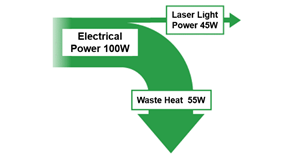
Waste Heat – Many customers do not appreciate the importance and/or the complexity of removing waste heat. Heat is the biggest cause of field failures, especially for higher power laser diodes. Waste heat must be removed efficiently and instantaneously, or the laser will be catastrophically  damaged or, as a minimum, experience a shortened lifetime.
damaged or, as a minimum, experience a shortened lifetime.
You must ensure the laser diode has an adequate heatsink for the waste heat produced.
A simple method for determining the amount of waste heat is to take the total input power (Amps*Voltage=Input Power Watts) minus the optical output power (Watts). The balance is the watts of max waste heat. Depending on the semiconductor laser type and wavelength, laser diodes are typically 10 – 60% efficient at converting electricity into light. This heat is generated within a small area, it is critical that the laser is securely connected to an adequate heatsink. See our new Lasers 101 page for in depth information on Solid State Lasers.
Operating Temperature – Most lasers have a recommended operating temperature and a location where this temperature is measured. If the laser is operated at a temperature higher than recommended, the lifetime of the laser is reduced exponentially as the operating temperature is increased above the recommended temperature. Diode laser degradation accelerates with increased temperature. For many laser diodes, operating at a temperature lower than recommended can slightly increase the output power (higher efficiency) and/or improve lifetime. Therefore, the operating temperature should be minimized when possible, but lowering the diode laser temperature below 15 °C is only suitable in a hermetically sealed housing with dry inert atmosphere (e.g. Nitrogen). Condensation will irreversibly damage laser diodes.
Heatsinks – Most all laser diode packages will need some sort of heatsinking. The heatsink must be capable of dissipating the waste heat generated by the laser. Lower power devices may only need to be mounted to a baseplate, higher power devices will need a more substantial heatsink or a forced air finned heatsink, and laser diodes arrays (bars) may need active cooling to handle the waste heat. The best heatsink material is copper, but aluminum is also a suitable heat conductor. If aluminum is used, the surface should not be anodized in the region where the laser package contacts the heatsink. The aluminum oxide anodized coating makes an effective thermal insulator. The surface of the heatsink should be machined flat and smooth where it will contact the mounting surface of the laser package to allow for efficient heat transfer. The heatsink surface should be finely milled or lapped (flatness: 0.5 μm, roughness: 0.5 μm), clean and free of scratches to guarantee good thermal contact. The heatsink may be cooled by air, water, or thermoelectric  coolers. Depending on the type of laser, an air-cooled heatsink may provide sufficient cooling. If sized correctly, an air-cooled heatsink can maintain an operating temperature a few degrees above your ambient temperature. If the ambient temperature changes, so do the heatsink temperature. This temperature change will not provide stability of the laser wavelength and output power. Most often, active cooling of the heatsink must be used. Actively cooled heatsinks offer much better heatsinking performance and introduce temperature control into the system. Active cooling usually is either water-cooling or thermoelectric coolers (TEC’s). The simplest design of an actively cooled heatsink is a metal plate with a cooling hole which allows coolant to flow thru the heatsink. Usually, water is used as a coolant, for ecological reasons and because of its high heat capacity.
coolers. Depending on the type of laser, an air-cooled heatsink may provide sufficient cooling. If sized correctly, an air-cooled heatsink can maintain an operating temperature a few degrees above your ambient temperature. If the ambient temperature changes, so do the heatsink temperature. This temperature change will not provide stability of the laser wavelength and output power. Most often, active cooling of the heatsink must be used. Actively cooled heatsinks offer much better heatsinking performance and introduce temperature control into the system. Active cooling usually is either water-cooling or thermoelectric coolers (TEC’s). The simplest design of an actively cooled heatsink is a metal plate with a cooling hole which allows coolant to flow thru the heatsink. Usually, water is used as a coolant, for ecological reasons and because of its high heat capacity.
Thermal spacer – An indium foil spacer can be used to reduce the thermal impedance of the laser package to heatsink interface. Our experience is that indium foil offers a negligible improvement over a good copper-to-copper interface. In permanent installations, some improvement of the heatsinking can be achieved using a silver-filled epoxy at this interface. If silver-filled epoxy is used, it should be a “space qualified” low outgassing to avoid contamination of the laser facets (Epoxy Technology H21D, for example).
Temperature Drop Check– When testing out a heatsink configuration, it is wise to test the temperature drop between the laser package and the heatsink using a very small thermocouple touched to the base of the laser package. The temperature drop during laser operation should be only 1-2° C.
Wavelength Check – Another test for the heatsink configuration is to check the laser emission wavelength at the specified current and operating temperature. A much longer wavelength than specified on the data supplied with the laser indicates bad thermal contact and thermal overload of the diode laser. The thermal contact must be improved before continuing laser operation. The laser emission wavelength will change with operating temperature: the wavelength increases approximately 1nm for every 4° C temperature increase (~0.25nm/K). This value varies by wavelength.
You can download our full white paper on How to Improve Laser Diode Lifetime: Advice and Precautions on Mounting below:

 SHIPS TODAY
SHIPS TODAY 